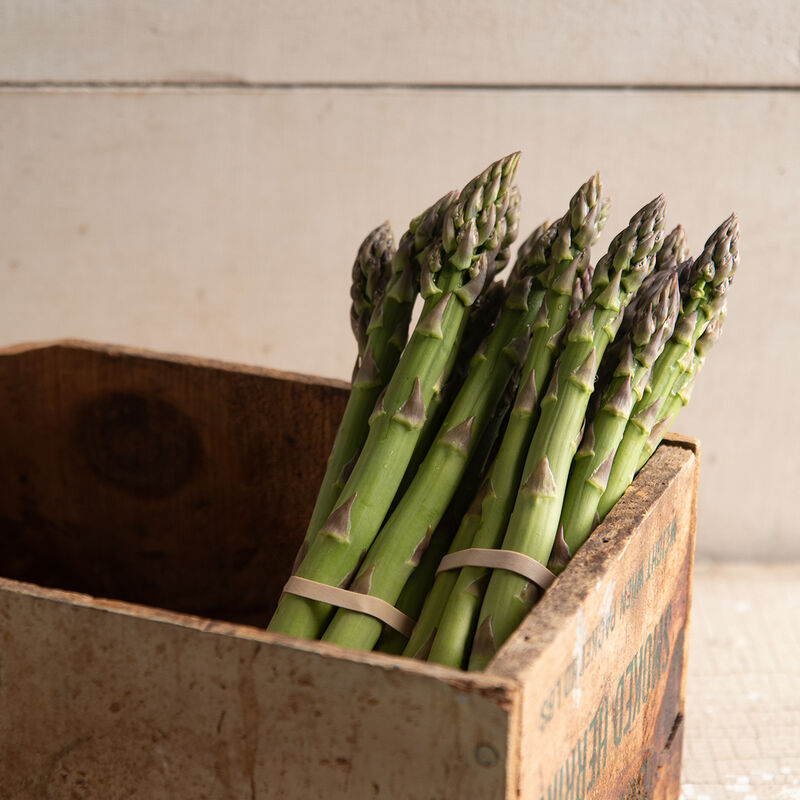Millennium (F1) Asparagus Seed
Millennium (F1) Asparagus Seed
Superior all-around performer.
A cold-hardy asparagus that maintains tip tightness as it grows. Since Millennium is well-adapted to various soil types, including heavier soils, growers can utilize land previously unsuitable for asparagus production. Higher yielding than Jersey Supreme, and over a longer period, with more fern vigor and survival, the same spear size and spring emergence, and a higher proportion of male plants; (male plants are more productive for spears, while female plants drop seeds, overcrowding the bed and causing smaller spears, weed issues, and increased asparagus beetle and disease pressure). Bred by Dr. Dave Wolyn at the University of Guelph in Ontario, Canada, Millennium is becoming the new industry standard for asparagus production. Perennial. Also available in conventional crowns.Disease Resistance:
Specs:
- This product does not ship to the following countries: United Arab Emirates, Austria, Australia, Barbados, Belgium, Bulgaria, Bermuda, Bahamas, Switzerland, Cyprus, Czech Republic, Germany, Denmark, Estonia, Spain, Finland, France, United Kingdom, Greece, Hong Kong, Croatia, Hungary, Ireland, Iceland, Italy, Japan, Republic of Korea, Kuwait, Cayman Islands, Lithuania, Luxembourg, Latvia, Malta, Netherlands, Norway, New Zealand, Oman, Poland, Portugal, Qatar, Romania, Saudi Arabia, Sweden, Singapore, Slovenia, Slovakia, San Marino, Thailand, Trinidad and Tobago, Taiwan, Ukraine.
SCIENTIFIC NAME:
Asparagus officinalisCULTURE:
Asparagus is a long-lived perennial vegetable crop. With proper site selection, preparation, and care, it can thrive for 15 years or more. Asparagus prefers well-drained, fertile soil with a pH of 7.2 or higher in full sun or part shade. Soil testing and bed preparation should be completed in the season prior to planting. May not perform well in warmer areas such as TX, MS, GA, LA, AL, or FL, as it may not become dormant, which is needed to prevent frost/freeze damage.GROWING FROM SEEDS:
Sow seeds indoors 12–14 weeks before desired transplant date. Sow 1 seed per 2" cell, ½–¾" deep. Germinate at 75–80°F (23–27°C) day, 65°F (18°C) night. Fertilize moderately as needed. After last frost, plant seedlings similarly to crowns, but use W-shaped furrow. Plant the seedlings in the middle of the W to ensure better drainage. Gradually fill in furrow as plants grow, being careful not to bury any small ferns.PLANTING CROWNS:
Crowns can be planted about 3–4 weeks prior to last average frost date. In a furrow 5–8" deep (shallower for heavy soils and deeper for colder regions), place crowns with buds up and roots spread out. Space green varieties 8–14" apart in-row and purple varieties 6–8" apart in-row; closer spacing of purple asparagus creates more slender spears. Allow 3–6' between rows. Cover crowns with 2–3" of soil at planting. As spears grow, gradually fill in furrow. Use caution when cultivating to avoid damaging crowns. Keep bed free of weeds (straw or leaf mulch works well) and irrigate regularly during establishment. Allow "ferns" to grow—do not cut until they senesce in the fall. Add compost or aged manure to the beds each fall or early spring.HARVEST:
One year after planting, beds can be harvested in spring for 7–10 days; 2 years after planting for 2–3 weeks, and up to 6 weeks in the third year. Marketable spears are approximately 6–9" in length and pencil-size or larger in diameter. Harvest by bending spears over until they snap, or cut just below soil surface. Cease harvesting when spears are less than pencil-size. Store harvested spears upright at 36°F (2°C) and 95–100% relative humidity for up to 2 weeks.SEEDS/LB. (AVG.):
16,000.PACKET:
30 seeds, sows approx. 25' depending on spacing.Johnny's is committed to your success, every step of the way.
We want you, our customer, to be 100% satisfied with all of our seeds, tools, and supplies.
If anything you purchase from us proves unsatisfactory, we will either replace the item or refund the purchase price.




